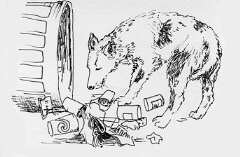This division of Albuquerque's Environmental Health Department, Animal Control Division (ACD), operates two facilities, one on the east side of Albuquerque, one on the west side. The address of the east side facility is 8920 Lomas Boulevard NE; the west side address is 11800 Sunset Garden SW.
The main goal of ACD is a mutual purpose: to protect city residents from annoyance or injury by animals, and to protect animals from cruelty, abuse, or neglect by people. Specifically, ACD is charged by the city council with housing animals in a controlled area, financing the functions of licensing and animal recovery, and establishing a program for sterilization of animals. ACD is also responsible for both the domestic and the wild animal populations in the city. The division accomplishes these goals through public information and enforcement of the city animal control ordinance.
The animal control ordinance was enacted in the late 1950s. Amendments are enacted on an "as needed," occasional basis. The ordinances covers every aspect of owners' duties for the individual city resident, breeders, refuges, shelters, pet shops, and grooming parlors. There are also sections regarding wild or exotic animals, guard dogs, and dog trainers. The Albuquerque ordinance is in accord with New Mexico state statutes, and copies of the city ordinance are available to any interested resident or group.
The major problem in Albuquerque, as in most cities, is pet over-population. There simply are not enough homes for the estimated 2,500 to 3,000 animals born every hour in the U.S. Most animal control and humane groups strongly advocate sterilization of companion animals. Fewer animals would mean fewer of the problems discussed below.
 Probably
the most relevant ordinance provision that affects the environment, deals with
estray animals. Estray is defined as "any animal found running at large
beyond the boundaries of the premises of the owner." This includes animals
deliberately set loose by owners to roam neighborhoods, accidental escape from
house or yard, or deliberate abandonment of animals. The resulting problems
are bites to humans (including bites that result in rabies), animals being hit
by cars, poisoning, disease risks to humans, starvation, dehydration, lack of
adequate shelter, impregnation of feral animals, nuisances (torn garbage bags,
defecation), the natural tendency of animals to form packs, feral animals, and
attacks on other pets and livestock.
Probably
the most relevant ordinance provision that affects the environment, deals with
estray animals. Estray is defined as "any animal found running at large
beyond the boundaries of the premises of the owner." This includes animals
deliberately set loose by owners to roam neighborhoods, accidental escape from
house or yard, or deliberate abandonment of animals. The resulting problems
are bites to humans (including bites that result in rabies), animals being hit
by cars, poisoning, disease risks to humans, starvation, dehydration, lack of
adequate shelter, impregnation of feral animals, nuisances (torn garbage bags,
defecation), the natural tendency of animals to form packs, feral animals, and
attacks on other pets and livestock.
Primarily because of abandonment of animals in some of the open space areas surrounding Albuquerque, the city does have a problem with feral animals (i.e., animals having escaped from domestication and become wild). Neither exact nor approximate numbers are known because of the elusive and often nocturnal nature of these animals, and until they become a reported danger or nuisance, feral animals continue to stray at will.
There is also a problem with domestic animals "packing" and chasing (even hunting) wild life in the mountain areas.
Compounding the various problems that Albuquerque faces in animal control is the inclusive and surrounding Bernalillo County, where there was little, if any, animal control until 1983. Until a serious animal attack on a young boy occurred in the county, there was little attention paid to either enacting or enforcing any ordinance. Many hope that there will be a continued, unified and concerted effort between city and county to solve these animal/people problems.
Furthermore, ACD intends to maintain or improve its level of services to city residents and their animals. ACD expects that both education and publicity for the centers will continue to have a positive effect on the public. It is a constant and recurring type of education that must take place. Animal control and animal welfare organizations have long said, "There are no animal problems, only people problems." It is hoped that with proper legislation, education, and enforcement, all these problems can be minimized to ensure the continued high quality of life in Albuquerque.
(Up to Section V, Back to Air Quality, On to Animals and Plants)